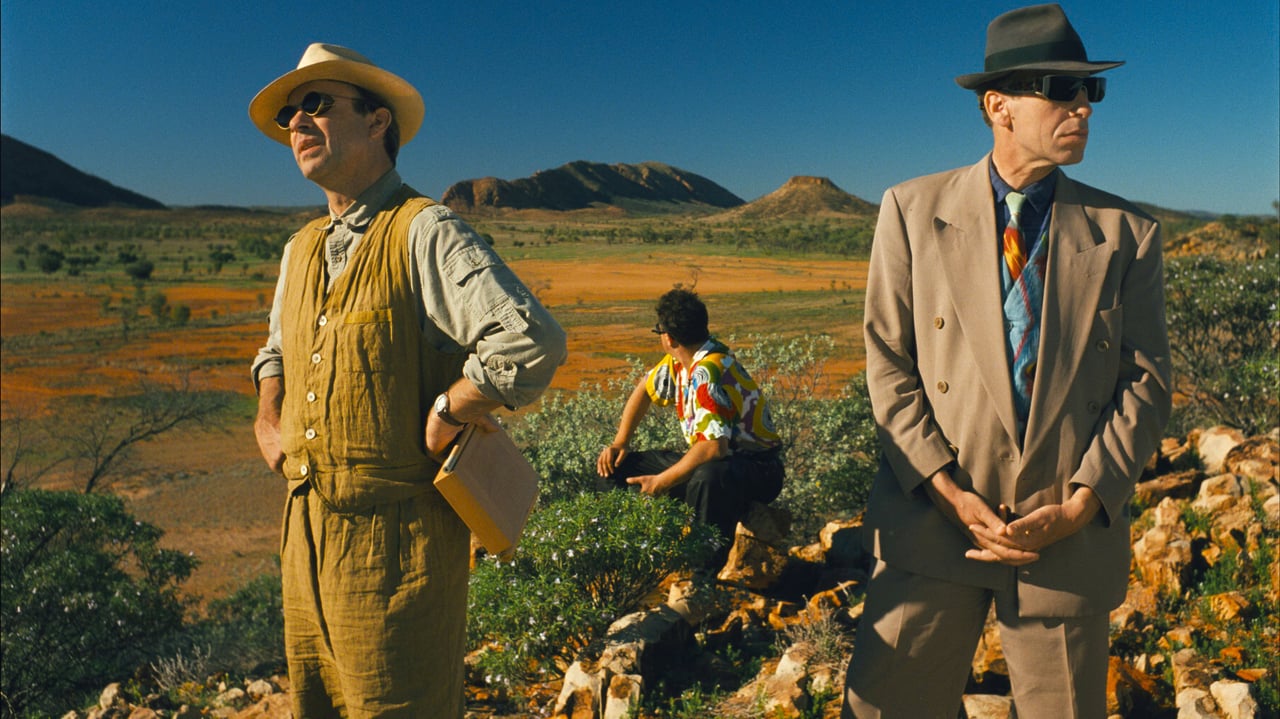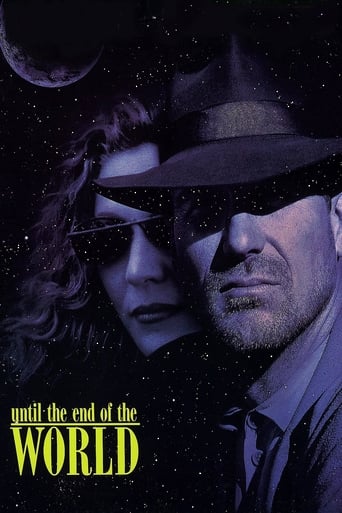

I've said it before to anyone who will listen and I will keep on saying it: Wenders has not put out decent film since "Wings of Desire"...everything after has been pure, disinteresting garbage, While everything before "Wings of Desire" are masterpieces. I think the problem here is Wenders should stop making American films, (this is where he has gone wrong) and instead go back to making European films that have subtle references to America(this is where he's gone right). I think that's the formula that worked so well for him. But his films aren't Eurotrash...For example, The American Friend, Alice in the Cities, Kings of the Road, I wouldn't consider "European", per-se. But story lines and characters that were universal and relatable on a human scale.
... View MoreI went to see that film with a Wenders' die hard fan. When we left, it was quite easy for her to recognise... That was utter rubbish.Paradoxically, she was bored all along while I was not, as I was busy laughing at loud at the innumerable ridiculous moments. The thing is, because Mr Wenders thinks he is smart, or deep, or whatever nonsense, he thinks he can make an SF oeuvre without a look at any earlier material in the genre. Of course he failed. His vision of the future is laughable in every aspect and detail.Into this conceptual and visual disaster, put a 10 minutes plot that drags on for hours. No amount of acting ability can save that recipe. Even the great Jeanne Moreau was wasted in this.The only redeeming moments, for me, came from the short parts of E. Mitchell and Chick Ortega, who for some reason seemed to really enjoy being there, and from a few beautifully filmed scenes here and there. Their worth is only by comparison to the general ineptitude, though, and in no way would justify watching this perfect specimen of turkey.
... View MoreI find this film to be beyond description - in some ways it is dated - the car map system looked cool when nobody had GPS. It reflects the visions of the cyberpunk literature and cultural movements of the late '80s and early '90s, which has some relevance, but has morphed beyond recognition.In actual 1999, I found a great prophetic irony in the opening lines: "1999 was the year the Indian Nuclear Satellite went out of control. No one knew where it might land. It soared above the ozone layer like a lethal bird of prey. The whole world was alarmed..."I rewrote them to reflect the actual reality: 1999 was the year the dot com and Y2K bug hype went out of control. No one knew where it might end. It soared above our corporate servers and venture-capital-burn-rate like a lethal bird of prey. The whole world was alarmed...So there are some decently interesting science fiction aspects to this movie, but I would say that this is actually the ultimate art film as road movie. Just see "Wings Of Desire" if you don't think Wenders is an art film director. Of course I have to give it extra points just for spending extra time in one of my favorite world-class bars - the Tosca.Even though this is a cyberpunk sci-fi film, and an art film and a road film, it manages ultimately to be introspectively psychological (as do all Wenders films that I have seen so far). I cannot watch this movie without shedding at least a tear for the beautiful and talented Solveig Dommarten, whose career and life were cut far too short. I see other reviews talking about the lack of story. This movie is better watched as painting - the title or theme may be short, but it unfolds in the tasting of the experience of the images, some of which were pretty striking in 1991. I thought the theatrical release was pretty good at the time, but if you can, slow down and watch the 5 hour trilogy version (a third at a time).
... View MoreWim Wenders over 5 hour globetrecking cyberpunk epic, is intended to be the ultimate road movie. It plays out like a miniseries, about a woman who just separated from her writer boyfriend(played by Sam Niel who serves as narrator), and crashes cars with wounded bank-robbers, they offer to give her some of the money if she will transport the cash the rest of the way to Paris for them. She agrees and uses her money to finance the trip that ensues for the rest of the movie. She immediately after meets William Hurt, a mysterious hitchhiker she becomes fascinated with. He is on the lamb, but from who, and why? After he ditches her and steals a hefty sum she becomes obsessed with finding him.All the while a rouge Indian nuclear satellite hovers above the Earth, haywire and endangering a possible nuclear Apocalypse if it accidentally detonates. The world is closer to ending than it has ever been, which means its just a story on the news in the background, most people try to ignore.The first segment, in this three part film, is their chase cross country and continent, "A Dance Around The World", as the book about their lives is latter called.They begin in Italy, and go on to Paris, Berlin, Moscow, Bejing, Tokyo, San Francisco, and finally the Australlian Outback, our heroin Miriam discovers, that Hurt is wanted for a stolen piece of Government property, a device that records the experience of seeing and translates the information as images. He is recording the most beautiful places in the world, for his blind mother. He is the son of Max Von Sydow, the inventor of the device. Their cat and mouse game becomes a whirlwind romance of constant movement and escape.By the third segment they reach Sydow's underground lab in Australlia, where they also discover that the device cannot only record seeing for the blind, but can record dreams if left on during sleep. The aboriginals who run the lab with Sydow refuse to work on his dream machine. Slowly but believably the rest of the staff, becomes obsessed with staring into the recordings of their dreams, "It got to the point where they dreamed of their dreams...and fell ever deeper into the black well of Narcissus .".There are car crashes, planes losing power midlight, and one gorgeous locale after another. Like "Alphaville" and "The Fall" this film is completely indebted to its beautiful sights, that it finds and photographs. At five hours long, you can imagine it meanders a good deal. And it does, but for a film so dedicated to the pure spectacle and profound importance and danger of "seeing things", I didn't mind.Future content wise, there is a clear opposition between the dual natures of the machine, helping the blind to see the world, and allowing the sightful to intrude upon their private internal world, whose appeal is magnetic and addictive. Tecnhology is a double edged sword, amazing but not without its serious ethical and philosophical dilemmas (which is the more real world the one within or without? etc), this movie doesn't delve into it conversation wise, it's lets everything play out, at five hours it gives you the credit that you can work it out for yourself.It's really just a beautiful film to watch, that's much sweeter and gentler than most sci-fi, and more fascinating too because it doesn't shove its implications down your throat.Wim Wenders, got people like The Talking Heads, Can, Lou Reed, Patti Smith, Elvis Costello, U2, Nick Cave, and many many more, to make original songs for the soundtrack about the new millennium. While many of the songs are very good, most are awkwardly placed as well. No doubt Wenders was really excited about all the music and just wanted to use everything.Definitely flawed, but a richly excessive and eccentric experiments and time capsule. Despite its hefty run time, I thought Wenders was sensitive, to the changing dynamics of the future world, it's not dystopian and it's not Star Trek/Fifth Element Space Opera either, it occupies, a space, where simple good or bad, are no longer really relevant to discussion.At one point when everyone assumes the world has ended Sam Niel's character is playing in a small band with several Aboriginal neural scientists, a few french-bank robbers, a British bounty hunter, and some random strays who wandered into the Australian compound fearful of nuclear fallout, and they play a music that sounds like Australlian Blue Grass; Didgeridoo's and pianos, harmonica's, and trumpets, blending together to create something singular and new. He notes to himself, "This entire trip has not been about helping a blind woman to see, or gazing into ourselves. But this adventure, the satellite, the machine, the crash, it all occurred, so we could be here, at this moment, to create this music which would have never otherwise existed, right at the crest of the end of the world".Few sci-fi films are dedicated to power of music(that the characters play), words(that Sam Neil records for his novel), and images(of coming war, of the beauty of the world, and the contours of our own mind/dream/souls,etc). In Alphaville when the computer asks Lemmy Caution, "What moves the night?", Caution responds, point blank, "Poetry". Wim Wenders updates, upgrades, and extends this concept for the new millennium. Though I cant remember too much of what was said, I'm still humming along days later, with some pretty pictures circulating in my head like post cards from an alternate universe.It's a bittersweet, love, travelogue, adventure story, for the New Millennium; "Where In The Wolrd Is Carmen San Diego?", as written by William Gibson on a sentimental day.
... View More